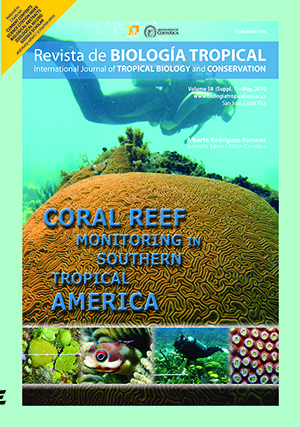Abstract
Coral reefs along the Eastern Brazilian coast extend for a distance of 800km from 12° to 18°S. They are the largest and the richest reefs of Brazil coasts, and represent the Southernmost coral reefs of the Southwestern Atlantic Ocean. Few reef surveys were performed in the 90’s in reef areas of Bahia State, particularly in the Abrolhos reef complex, in the Southernmost side of the state. A monitoring program applying the Atlantic and Gulf Rapid Reef Assessment (AGRRA) protocol was initiated in 2000, in the Abrolhos National Marine Park, after the creation of the South Tropical America (STA) Regional Node of the Global Coral Reef Monitoring Network (GCRMN) by the end of 1999. From that time up to 2005, nine reef surveys were conducted along the coast of the State of Bahia, including 26 reefs, with 95 benthic sites, 280 benthic transects, 2025 quadrats and 3537 stony corals. Eighteen of the 26 investigated reefs were assessed once and eight reefs of Abrolhos were surveyed twice to four times. The MDS ordination, analysis of similarity (ANOSIM, one way and two-way nested layouts) and similarity percentages (SIMPER) tests were applied to investigate the spatial and temporal patterns of reef vitality. Four indicators of the coral vitality: live coral cover, the density of the larger corals (colonies >20cm per reef site) and of the coral recruits (colonies<2cm per square meter), and the percentage of macroalgae indicate that the nearshore reefs, which are located less than 5km from the coast, are in poorer condition than the reefs located more than 5km off the coast. A higher density of coral colonies, lower macroalgal index, higher relative percent of turf algae and higher density of coral recruits in offshore reefs compared to the nearshore reefs are the conditions that contribute more than 80% to the dissimilarity between them. The offshore reefs are in better vital condition than the nearhore reefs and have a set of vitality indices more closely related to the Northwestern Atlantic reefs than the nearshore reef. These have been most severely impacted by the effects of direct human activities such as euthrophic waters associated with sewage pollution, higher sedimentation rates and water turbidity, inadequate use of the reefs and over exploitation of their resources. The implementation of a more effective coral reef monitoring program in Bahia is mandatory, in order to improve the strategies for protection and management efforts of the reefs.##plugins.facebook.comentarios##

This work is licensed under a Creative Commons Attribution 4.0 International License.
Copyright (c) 2010 Revista de Biología Tropical






